|
HOME: www.hiltonpond.org |
|||
THIS MONTH (Back to Preceding Week; on to Next Week) |
TWO NEW MIDSUMMER WILDFLOWERS After a lengthy hiatus brought about by myriad factors, we've finally had time to put together another on-line installment about natural history happenings in our neck of the Carolina Piedmont. It's been so long we're calling this edition "This MONTH at Hilton Pond" because it covers all of July. We can't possibly summarize everything we observed in those 31 days, so instead we'll concentrate on a couple of new plants we found growing at Hilton Pond Center--two new wildflower species that showed up for the first time in 2012. After more than three decades on-site it's seldom we come across any plant not yet documented locally, so please share our excitement over adding TWO more floral species to the Center's inventory.
All text & photos © Hilton Pond Center Our first new species suddenly appeared this summer at several spots along the edge Hilton Pond, rooted in the muddy banks exposed as our lengthy drought continues. Around the first of July we noticed several unfamiliar four-foot-tall vegetative stalks (above) towering above surrounding pond bank vegetation. (Note also the web of an orbwever spider that used one stem as a place to anchor its silken snare.)
All text & photos © Hilton Pond Center The stalks soon gave rise to pale bluish-purple inch-long flowers (above) that were bilaterally symmetric and had yellow centers. The blossoms looked a little like snapdragons, so our initial suspicion was the plant was in the Scrophulariaceae (the Figwort or Snapdragon Family).
All text & photos © Hilton Pond Center Also obvious were the plant's opposite leaves AND its opposite flower stems springing from the leaf axils, as shown in the image above. Four-inch-long lance-shaped leaves were lightly serrated, except near their bases.
All text & photos © Hilton Pond Center Quite interestingly, when we rolled a main stem between thumb and forefinger we could tell it was square. (See highly magnified cross-section above. The stem also turned out to be hollow.) A square stem often indicates a member of the Mint Family (Lamiaceae), but the plant was not aromatic and the flower only superficially resembled that of a mint; thus, we stayed with our snapdragon ID. Although we weren't familiar with this new plant we figured we knew how to find out what it was. In the old days we would have grabbed our well-worn copy of the 1,200-page "Manual of the Vascular Flora of the Carolinas" (authored by Radford, Ahles & Bell) and flipped to the section on snapdragons to pore through technical descriptions until we came to an ID that seemed right. Now that we're operating in the 21st century, however, we went straight to our trusty Macintosh computer, opened our Safari Web browser, and Googled these words: "tall pale blue flower opposite square stem wetland South Carolina snapdragon." The first page that came up was one with images of blue summer wildflowers of East Tennessee and, sure enough, while scrolling down we came to a photo of the exact plant we had found at Hilton Pond: Mimulus ringens, the Square-stemmed Monkeyflower (AKA Allegheny Monkeyflower.) With that name in hand it was back to the hardbound manual, which confirmed our on-line identification: Square-stemmed Monkeyflower it was!
All text & photos © Hilton Pond Center The printed manual had a nice paragraph whose concise terms would be music to the ear of a trained botanist or knowledgeable layperson: "Erect, glabrous perennial to one meter or more tall, stems square, wingless or wings obscure. Leaves lanceolate or lance-elliptic, mostly 6-13 cm long, 1.7-3 cm wide, serrate at least above the middle, sessile, the bases often clasping. Corolla lavender to nearly white, the throat shaded with yellow, 2.5-4 cm long. Capsule [i.e. the seed pod, shown above with the pistil still extended] ellipsoid, 10-12 mm long, enclosed by the calyx. June-Sept. Marshes, bogs, stream banks, and wet meadows; chiefly mts. and pied." What an apt, accurate, and scientifically poetic description for this new species growing on the banks of Hilton Pond. After making sure we knew the identify of our pond side plant we went back to Google and typed in the scientific name to do some more Internet reading. We learned the genus Mimulus concentrates sodium chloride in leaves and stems; early settlers used Monkeyflower as a flavoring for venison and squirrel. Its rather large, unspecialized infloresence is pollinated primarily by Bumblebees and Mason Bees. We also found Monkeyflowers are so named because their blossoms supposedly resemble the face of a primate. Furthermore, it turns out Mimulus was indeed once classified in the Snapdragon Family, but DNA studies have led botanists to move Monkeyflowers into the much smaller Lopseed Family (Phrymaceae). Such is almost the norm these days in both the plant and animal kingdoms. DNA analysis upsets time-honored taxonomies by showing organisms thought to be closely related based on appearance are actually very different genetically. Regardless of how it's classified, however, we were happy to see this newly arrived native wildflower sprouting profusely on the banks of Hilton Pond. How it got there all of a sudden in 2012 is anybody's guess.
All text & photos © Hilton Pond Center While plodding along the muddy pond margin and photographing the as-yet-unidentified Square-stemmed Monkeyflower, we were most surprised to spy another wildflower for which we already knew the name. It was brilliant red and is on our Operation RubyThroat list of "Top Ten Native Hummingbird Flowers" but we'd never found it anywhere on the property at Hilton Pond Center. How pleased we were to finally add Cardinal Flower, Lobelia cardinalis, to the Center's native plant list. Its means of arrival is just as mysterious as that of the Monkeyflower, but the mechanism matters not; Cardinal Flower is a very welcome addition.
All text & photos © Hilton Pond Center As its scientific name indicates, Cardinal Flower is one of the lobelias, a rather large genus of perhaps 400 species of plants that occur primarily in the tropics. Lobelias are another of those enigmatic groups that gives fits to plant taxonomists; some experts claim lobelias are in their own family--the Lobeliaceae--while others place them in the Campanulaceae (Bellflower Family). In any case, all the lobelias bear flowers that are more or less tubular.
All text & photos © Hilton Pond Center In Cardinal Flower (see two photos just above) the inch-long corolla is split at the top. The flower's upper lip has two more or less erect lobes while the lower lip is wide and cleft into three lobes.
All text & photos © Hilton Pond Center Five stamens bearing yellow pollen grains (above) are united around the feathery female style and extend out beyond the rest of the flower, curving downward. This is right where the Cardinal Flower's reproductive structures hit the crown or forehead of a nectar-probing hummingbird, allowing for efficient pollen transfer.
All text & photos © Hilton Pond Center The Cardinal Flower stalk bears a blossom cluster that starts with a few flowers and, as the season progresses, may produce a succession of 30 or more individual blooms. Once fertilized, each flower withers, drops its petals, and quickly forms a spherical capsule (above) up to an inch in diameter. The capsule eventually dries and turns brown, releasing numerous oddly textured caramel-colored seeds that germinate to form a large rosette the first spring. Cardinal Flower takes two years to bloom. The species upon becoming established is perennial; it also propagates by basal offshoots.
All text & photos © Hilton Pond Center Cardinal Flower is definitely a moisture-loving native that does best in bright or partial sunshine on the banks of streams, drainage ditches, and ponds (above). Formerly found only in northeastern and north central states, Cardinal Flower has been introduced widely throughout much of North America where it blooms July through September--making it a valuable nectar source for hungry Ruby-throated Hummingbirds as they make their way way south in fall migration. Cardinal Flower can be locally common but may become decimated in the wild within its original range from habitat loss, injudicious riparian herbicide use, and thoughtless passersby who pick, admire, and discard its blossoms before the flower head can set seed and propagate. Fortunately, the species does well in cultivation. Although "Cardinal Flower" is a lovely epithet, some of the lobelias have less than pleasant common names including asthma weed, barfweed, heaveleaf, pukeweed, retchwort, fool's bane, and vomitwort. From this one might correctly conclude lobelias are not likely to appear on anyone's list of edible plants. Indian Tobacco, Lobelia inflata, was used by Native Americans as a purgative and shows potential as a means of treating methamphetamine addiction and drug-resistant tumors, and Cardinal Flower itself was dried and used among the Iroquois for cramps and fever blisters. Despite Cardinal Flower's medicinal uses and the salt-substitute capabilities of Square-stemmed Monkeyflower, we think we'll just be letting our two newly discovered native plants grow, make seeds, and flourish on the banks of Hilton Pond. All text, maps & photos © Hilton Pond Center All contributions are tax-deductible |
|---|
 The Piedmont Naturalist, Volume 1 (1986)--long out-of-print--has been re-published by author Bill Hilton Jr. as an e-Book downloadable to read on your iPad, iPhone, Nook, Kindle, or desktop computer. Click on the image at left for information about ordering. All proceeds benefit education, research, and conservation work of Hilton Pond Center for Piedmont Natural History. The Piedmont Naturalist, Volume 1 (1986)--long out-of-print--has been re-published by author Bill Hilton Jr. as an e-Book downloadable to read on your iPad, iPhone, Nook, Kindle, or desktop computer. Click on the image at left for information about ordering. All proceeds benefit education, research, and conservation work of Hilton Pond Center for Piedmont Natural History. |
|
|
"This Week at Hilton Pond" is written and photographed by Bill Hilton Jr., executive director of Hilton Pond Center for Piedmont Natural History
|
|
|
Please refer "This Week at Hilton Pond" to others by clicking on this button: |
Comments or questions about this week's installment? Send an E-mail to INFO. (Be sure to scroll down for a tally of birds banded/recaptured during the period, plus other nature notes.) |

Click on image at right for live Web cam of Hilton Pond,
plus daily weather summary
Transmission of weather data from Hilton Pond Center via WeatherSnoop for Mac.
|
--SEARCH OUR SITE-- For a free on-line subscription to "This Week at Hilton Pond," send us an |
|
Thanks to the following fine folks for recent gifts in support of Hilton Pond Center for Piedmont Natural History and/or Operation RubyThroat: The Hummingbird Project. Your tax-deductible contributions allow us to continue writing, photographing, and sharing "This Week at Hilton Pond" with students, teachers, and the general public. Please see Support or look below if you'd like to make a gift of your own.
|
If you enjoy "This Week at Hilton Pond," please help support Hilton Pond Center for Piedmont Natural History. It's painless, and YOU can make a difference! (Just CLICK on a logo below or send a check if you like; see Support for address.) |
|
Make credit card donations on-line via Network for Good: |
|
Use your PayPal account to make direct donations: |
|
If you like shopping on-line please become a member of iGive, through which 950+ on-line stores from Amazon to Lands' End and even iTunes donate a percentage of your purchase price to support Hilton Pond Center.  Every new member who registers with iGive and makes a purchase through them earns an ADDITIONAL $5 for the Center. You can even do Web searches through iGive and earn a penny per search--sometimes TWO--for the cause! Please enroll by going to the iGive Web site. It's a painless, important way for YOU to support our on-going work in conservation, education, and research. Add the iGive Toolbar to your browser and register Operation RubyThroat as your preferred charity to make it even easier to help Hilton Pond Center when you shop. Every new member who registers with iGive and makes a purchase through them earns an ADDITIONAL $5 for the Center. You can even do Web searches through iGive and earn a penny per search--sometimes TWO--for the cause! Please enroll by going to the iGive Web site. It's a painless, important way for YOU to support our on-going work in conservation, education, and research. Add the iGive Toolbar to your browser and register Operation RubyThroat as your preferred charity to make it even easier to help Hilton Pond Center when you shop. |
|
BIRDS BANDED THIS MONTH at HILTON POND CENTER 1-31 July 2012 |
|
|
SPECIES BANDED THIS MONTH: * = New species for 2012 MONTHLY BANDING TOTAL: 6 species 154 individuals 2012 BANDING TOTAL: 31-YEAR BANDING GRAND TOTAL: (since 28 June 1982, during which time 171 species have been observed on or over the property) 126 species (31-yr avg = 66.5) 57,681 individuals (31-yr avg = 1,861) NOTABLE RECAPTURES THIS MONTH: American Goldfinch (1) All text & photos © Hilton Pond Center |
OTHER NATURE NOTES: --We also fared very well in July with returns of Ruby-throated Hummingbirds we had banded locally in previous years--24 of them, to be exact (see list at left). These included Y15972, a female RTHU banded at Hilton Pond in 2006 and recaptured EVERY summer since--making her a 7th year bird! Even older, however, was Y15895--also caught in 2006 but as an adult; this makes her an after-7th-year individual who is approaching the nine-year longevity record for RTHU. --Our hummers were really humming in the month just completed, but local House Finches were even more plentiful with 82 banded at the Center during July. The vast majority of these were young birds of the year, many of which likely will not survive in the long run--especially since several showed signs of eye infections. This highly contagious conjunctivitis is the the bane of the eastern population of HOFI and causes significant mortality. Newly captured fledglings appear to have a higher rate of infection, which leads us to wonder if they get exposed as nestlings by parents that survived conjunctivitis but still carry the bacterium. All text & photos © Hilton Pond Center |


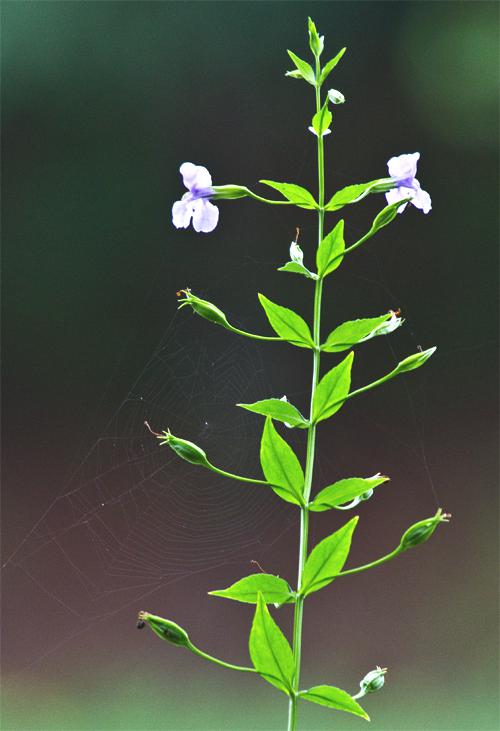


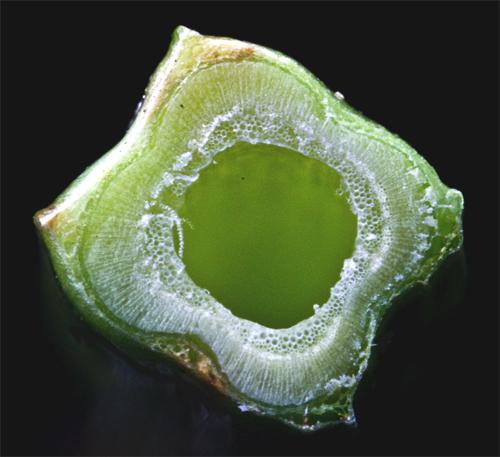
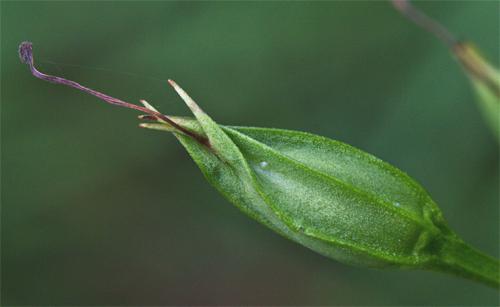
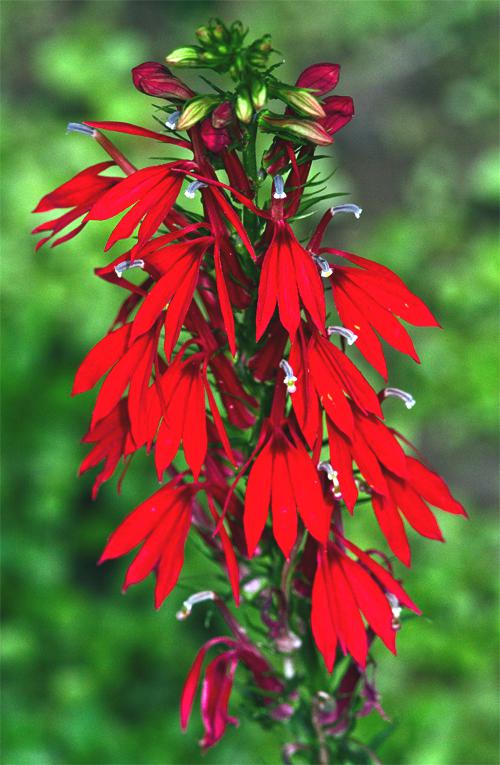
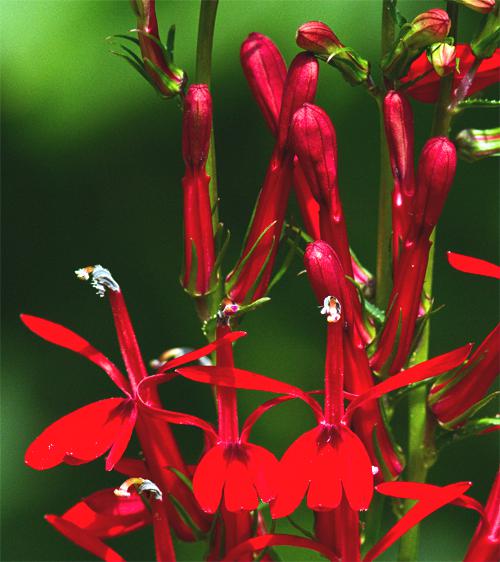
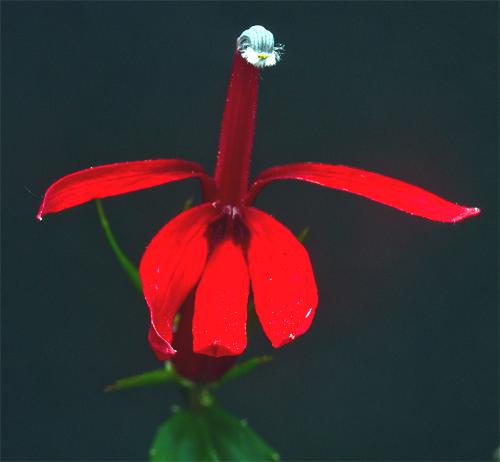
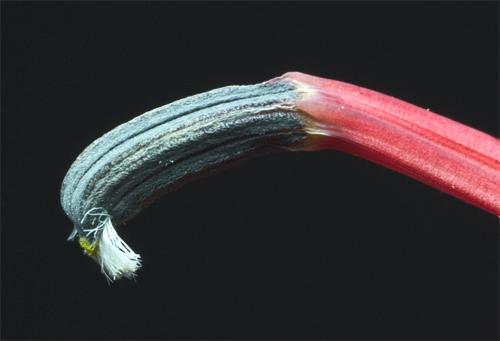
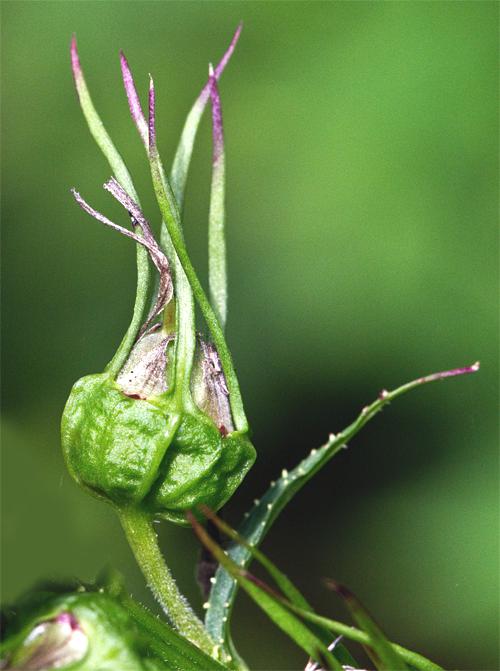
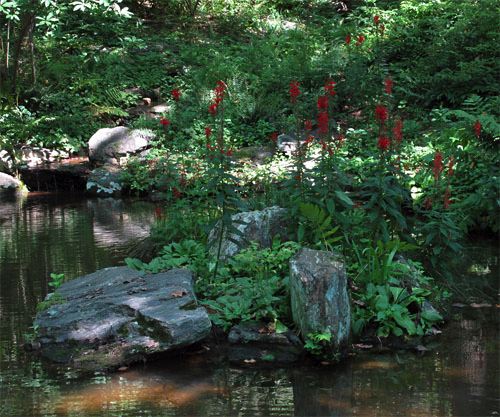


 Please report your sightings of
Please report your sightings of